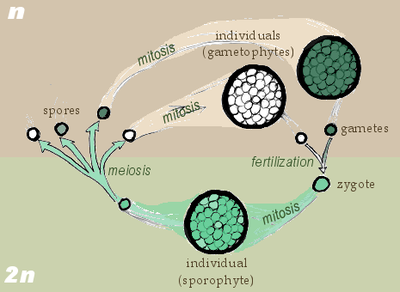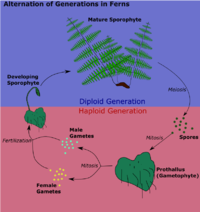Alternation of generations
2007 Schools Wikipedia Selection. Related subjects: General Biology
Alternation of generations is a reproductive cycle of certain vascular plants, fungi, and protists. The term is a bit confusing for people familiar only with the life cycle of a typical animal. A more understandable name would be "alternation of phases of a single generation" because we usually consider a generation of a species to encompass one complete life cycle. The life cycle of organisms with "alternation of generations" is characterized by each phase consisting of one of two separate, free-living organisms: a gametophyte ( thallus (tissue) or plant), which is genetically haploid, and a sporophyte (thallus or plant), which is genetically diploid.
A haploid plant of the gametophyte generation produces gametes by mitosis. Two gametes (originating from different organisms of the same species or from the same organism) combine to produce a zygote, which develops into a diploid plant of the sporophyte generation. This sporophyte produces spores by meiosis, which germinate and develop into a gametophyte of the next generation. This cycle, from gametophyte to gametophyte, is the way in which plants and many algae undergo sexual reproduction.
Distinctions
The distinction of "free-living" is important, because all sexually reproducing organisms can be thought to involve alternating phases, at least at the cellular level as meiosis. However, not all biologists agree. It is often stated that alternation of generations refers to both the diploid and haploid stages being "multicellular" and this is more important than "free-living" . Such a distinction changes the concept to one separating animals and plants.
All plants have diploid sporophyte and haploid gametophyte stages that are multicellular, and the differences between plant groups are in the relative sizes, forms, and trophic abilities of the gametophyte or sporophyte forms, as well as the level of differentiation in the gametophytes. An example would be comparing pollen and ovules to bisexual gametophyte thalli. Both approaches are discussed in this article.
Biologists recognize two categories of alternation: the first if the sporophyte and the gametophye forms are more or less identical, alternation is called isomorphic; and second if the forms have very different appearances, alternation is called heteromorphic. Other terms applied to this kind of life cycle are diplobiontic, diplohaplontic, haplodiplontic, or dibiontic.
Heterogamy is a term used to describe alternation between parthenogenic and sexually reproductive phases that occurs in some animals. Although conceptually similar to "alternation of generations", the genetics of heterogamy is significantly different.
Fungi
Fungal mycelia are typically haploid. When mycelia of different mating types meet, they produce two multinucleate ball-shaped cells, which join via a "mating bridge". Nuclei move from one mycelium into the other, forming a heterokaryon (meaning "different nuclei"). This process is called plasmogamy. Actual fusion to form diploid nuclei is called karyogamy, and may not occur until sporangia are formed. Karogamy produces a diploid zygote, which is a short-lived sporophyte that soon undergoes meiosis to form haploid spores. When the spores germinate, they develop into new mycelia.
Protists
Some protists undergo an alternation of generations, including the slime molds, foraminifera, and many marine algae.
The life cycle of slime molds is very similar to that of fungi. Haploid spores germinate to form swarm cells or myxamoebae. These fuse in a process referred to as plasmogamy and karyogamy to form a diploid zygote. The zygote develops into a plasmodium, and the mature plasmodium produces, depending on the species, one to many fruiting bodies containing haploid spores.
Foraminifera undergo a heteromorphic alternation of generations between a haploid gamont and a diploid agamont phases. The single-celled haploid organism is typically much larger than the diploid organism.
Alternation of generations occurs in almost all marine algae. In most red algae, many green algae, and a few brown algae, the phases are isomorphic and free-living. Some species of red algae have a complex triphasic alternation of generations. Kelp are an example of a brown alga with a heteromorphic alternation of generations. Species from the genus Laminaria have a large sporophytic thallus that produces haploid spores which germinate to produce free-living microscopic male and female gametophytes.
Plants
Non-vascular plants
Nontracheophyte plants including the liverworts, hornworts and mosses undergo an alternation of generations; the gametophyte generation is the most common. The haploid gametophyte produces haploid gametes in multicellular gametangia. Female gametangia are called archegonium and produce eggs, while male structures called antheridium produce sperm. Water is required so that the sperm can swim to the archegonium, where the eggs are fertilized to form the diploid zygote. The zygote develops into a sporophyte that is dependent on the parent gametophyte. Mature sporophytes produce haploid spores by meiosis in sporangia. When a spore germinates, it grows into another gametophyte.
Vascular plants
Ferns and their allies, including clubmoss and horsetails, reproduce via an alteration of generations. The conspicuous plant observed in the field is the diploid sporophyte. This plant creates by meiosis single-celled haploid spores which are shed and dispersed by the wind (or in some cases, by floating on water). If conditions are right, a spore will germinate and grow into a rather inconspicuous plant body called a prothallus.
The haploid prothallus does not resemble the sporophyte, and as such ferns and their allies have a heteromorphic alternation of generations. The prothallus is short-lived, but carries out sexual reproduction, producing the diploid zygote that then grows out of the prothallus as the sporophyte.



